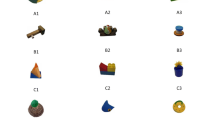Abstract
Verbally competent volunteers, 6 male and 6 female, served as participants. They were exposed to two experimental procedures. Initially two nonsense syllables (A2 and C1) were paired with positive adjectives and two nonsense syllables (A1 and C2) were paired with negative adjectives, using a procedure analogous to classical conditioning. Following this they were exposed to a stimulus equivalence training procedure. They were taught to match three nonsense syllables A1, A2, and A3 to three novel nonsense syllables B1, B2, and B3 respectively, and subsequently to match B1, B2, and B3 to three new nonsense syllables C1, C2, and C3. Testing revealed that the equivalence class involving entirely neutral stimuli (A3, B3, and C3) emerged for most participants but that the classes involving A and C stimuli that had acquired opposite meanings from the first procedure did not emerge.
Similar content being viewed by others
References
BARNES, D., LAWLOR, H., SMEETS, R M., & ROCHE, B. (1996). Stimulus equivalence and academic self-concept among mildly mentally handicapped and nonhandicapped children. The Psychological Record, 46, 87–107.
CAIRNS, E. (1980). The development of ethnic discrimination in young children in Northern Ireland. In J. Harbison & J. Harbison (Eds.), Children and young people in Northern Ireland: A society under stress. Somerset: Open Books.
LEADER, G., BARNES, D., & SMEETS, P. M. (1996). Establishing equivalence relations using a respondent-type training procedure. The Psychological Record, 46, 685–706.
LESLIE, J. C., TIERNEY, K. J., ROBINSON, C. P., KEENAN, M., & WATT, A. (1993). Differences between clinically anxious and non-anxious subjects in a stimulus equivalence training task involving threat words. The Psychological Record, 43, 153–161.
MOXON, P. D., KEENAN, M., & HINE, L. (1993). Gender role stereotyping and stimulus equivalence. The Psychological Record, 43, 381–394.
OSGOOD, C. E., SÚCI, G. J., & TANNENBAUM, P. H. (1957). The measurement of meaning. Urbana: University of Illinois.
SIDMAN, M. (1986). Functional analysis of emergent verbal classes. In T. Thompson & M. D. Zeiler (Eds.), Analysis and integration of behavioural units (pp. 213–245). NJ: Lawrence Erlbaum.
STAATS, C. K., & STAATS, A. W. (1957). Meaning established by classical conditioning. Journal of Experimental Psychology, 54, 74–80.
STEELE, D. M. (1987). Teaching the relations of same, opposite, and different. Unpublished doctoral dissertation, University of North Carolina, Greensboro.
WATT, A., KEENAN, M., BARNES, D., & CAIRNS, E. (1991). Social categorization and stimulus equivalence. The Psychological Record, 41, 33–50.
WILCOXON, F. (1947). Probability tables for individual comparisons by ranking methods. Biometrics, 3, 119–122.
Author information
Authors and Affiliations
Rights and permissions
About this article
Cite this article
Peoples, M., Tierney, K.J., Bracken, M. et al. Prior Learning and Equivalence Class Formation. Psychol Rec 48, 111–120 (1998). https://doi.org/10.1007/BF03395261
Published:
Issue Date:
DOI: https://doi.org/10.1007/BF03395261




